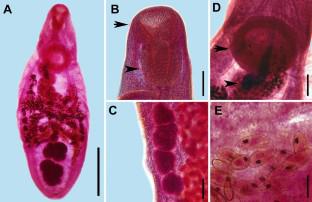目的
菲眼吸虫属的物种是具有复杂分类学的眼吸虫,直到最近才在分子数据的帮助下开始改进。然而,大多数描述的物种从未被置于系统发育背景中。在这项研究中,对之前在来自巴西的海带鸥( Larus dominicanus )上发现的眼吸虫进行了分子分析,该眼吸虫被鉴定为Philophamus lacrymosus 。
方法
为了进行分子分析,我们分析了从巴西圣卡塔琳娜州不同城市收集的六只受感染的海鸥(每只鸟一只蠕虫)中发现的寄生虫。我们对 28S 和cox 1 基因的部分区域进行了扩增和测序,并将获得的数据与 Philophamid 物种可用的序列进行比较,并进行系统发育分析。
结果
来自巴西的P. lacrymosus分离株与其他 5 个Philophamus物种组成了得到充分支持的进化枝,其序列可用于比较。与Philophamus spp 的其他分离株相比,28S 中的种间差异为 0.1-1.6%,c ox 1 中的种间差异为 8.2-14.9%。在来自不同地区的海鸥的六种眼吸虫分离株之间发现了两种cox 1 单倍型,其中一个核苷酸存在差异(0.1%)。巴西分离株与葡萄牙的P. lacrymosus寄生虫属于一个分支;然而, cox 1 (8.2–8.5%) 中发现的分子差异强烈表明这些分离株属于不同的物种。所获得的系统发育树和Cloacitrema属和Parorchis属物种的属间分化并不支持Natterolookingmus属的有效性,过去曾提出P. lacrymosus为该属的模式种。
结论
由于P. lacrymosus是在巴西描述的,我们建议将该名称应用于南美分离株,并将葡萄牙分离株暂时视为Philophamus sp.,一种可能的隐秘物种。此外,获得的数据支持先前基于形态学的Nattero眼属和Philo眼属之间的同义。考虑到我们的结果和之前关于南美洲P. lacrymosus的大部分报告,我们认为该物种呈现出海洋生命周期。
图解摘要
 "点击查看英文标题和摘要"
"点击查看英文标题和摘要"
A Molecular Phylogenetic Study of the Eye Fluke Philophthalmus lacrymosus (Trematoda: Philophthalmidae) Found in Larus dominicanus (Aves: Laridae) from Brazil
Purpose
Species of the genus Philophthalmus are eye flukes with a complex taxonomy, which began to be improved with the help of molecular data only recently. However, most described species have never been placed into a phylogenetic context. In this study, eye flukes previously found on kelp gulls, Larus dominicanus, from Brazil and identified as Philophthalmus lacrymosus were subjected to molecular analysis.
Methods
For the molecular analyses, we analyzed parasites found in six infected gulls (one worm per bird) collected from different municipalities of the state of Santa Catarina, Brazil. We carried out the amplification and sequencing of the partial region of the 28S and cox1 genes and the data obtained were compared with sequences available to philophthalmid species and subjected to phylogenetic analysis.
Results
The isolates of P. lacrymosus from Brazil grouped in well-supported clades with five other species of Philophthalmus with sequences available for comparison. Interspecific divergences of 0.1–1.6% in 28S and 8.2–14.9% in cox1 were found in relation to other isolates of Philophthalmus spp. Two cox1 haplotypes differing in one nucleotide (0.1%) were found between the six eye flukes isolates in gulls from different localities. The Brazilian isolates grouped in a subclade with parasites identified as P. lacrymosus in Portugal; however, the molecular divergences found in cox1 (8.2–8.5%) strongly suggest that these isolates belong to different species. The phylogenetic trees obtained and the intergeneric divergences to species of the genera Cloacitrema and Parorchis did not support the validity of the genus Natterophthalmus, for which P. lacrymosus was proposed as the type species in the past.
Conclusion
As P. lacrymosus was described from Brazil, we recommend that this name be applied to the South American isolates and that the Portuguese isolates be provisionally considered as Philophthalmus sp., a probable cryptic species. Moreover, data obtained supports the previous morphology-based synonymizing between Natterophthalmus and Philophthalmus. Considering our results and most of previous reports of P. lacrymosus in South America, we suggest this species presents a marine life cycle.
Graphical Abstract



































 京公网安备 11010802027423号
京公网安备 11010802027423号